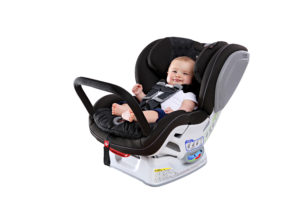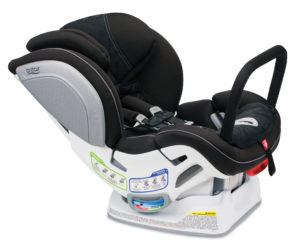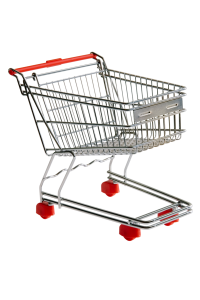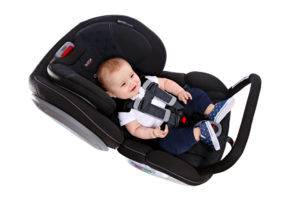 As you may know, all car seats sold in the U.S. must meet Federal Motor Vehicle Safety Standard (FMVSS) No. 213. This regulation helps protect your child in the event of a front collision (the most common type of crash).
As you may know, all car seats sold in the U.S. must meet Federal Motor Vehicle Safety Standard (FMVSS) No. 213. This regulation helps protect your child in the event of a front collision (the most common type of crash).
FMVSS 213 sets the bar pretty high. “Even with the levels of misuse we know that happens out there, car seats are incredibly effective at reducing injuries and fatalities to children,” says Kristy Arbogast, PhD, engineering core director at Children’s Hospital of Philadelphia. (It’s estimated that 73 percent of car seats are installed incorrectly.)
Meanwhile, car seat manufacturers are going above FMVSS 213 to develop seats that protect the youngest passengers in the event of a collision. A load leg is one example of a car seat tweak that surpasses current safety standards. The steel-enforced rod, which attaches to the infant car seat base, provides added stability to reduce the risk of movement and injury in the event of an accident.
But there’s a newish kid in town you should also know about–another car seat feature that exceeds FMVSS 213: The anti-rebound bar. If you’re in the market for an infant or convertible car seat, here’s why you should put one with an anti-rebound bar on your radar.
What is an Anti-rebound Bar?
Generally made of padded steel, an anti-rebound bar attaches to the end of a convertible car seat (used rear facing only) to limit the amount of rebound movement in the event of front-impact crash by 40 percent, according to Britax, which was the first car seat manufacturer to introduce the anti-rebound bar back in 2003. It may also help anchor the seat in the event of a rear or side-impact collision.
You can also find anti-rebound bar on infant car seats, built in to the base (the part that stays in your car). More on those in a minute.
An anti-rebound bar forms a rigid L shape against your car’s backset to limit rebound motion so that your baby’s head is less likely to hit the back of the seat in the event of a front or backend collision. Britax explains:
An anti-rebound bar is regulation on car seats in Canada. But within the last few years, this feature, which has been around in the U.S. since 2003—has started taking off. Here’s a sampling of seats sold in the U.S. with an anti-rebound bar.
Infant Car Seats — with Anti-Rebound Bar
Evenflo SafeMax infant car seat
The Evenflo SafeMax infant car seat has been designed and tested for structural integrity at energy levels two times the federal crash test standard and tested to simulate a side impact event ad rollover event.
The 9-pound car seat pairs with the Evenflo Pivot stroller, to become a modular travel system. Use it rear facing only from 4 to 35 pounds, then use a convertible car seat rear facing until age 2.
Baby Trend Inertia Infant Seat
Baby Trend’s version of an anti-rebound bar is a “controlled motion base.” It’s compatible with all Baby Trend infant car seats and available as an add-on for around $75. To install it, you’ll use your vehicle’s Latch connectors.
The Inertia infant car seat is compatiable with these strollers: Baby Trend’s Sit n Stand, Snap N’ Go and all Baby Trend jogging strollers except their Snap Gear, Snao Fit and Snap Tech models.
Convertible Car Seats

Britax Advocate Clicktight ARB
Britax Advocate ClickTight ARB
and
Britax Boulevard ClickTight ARB
An anti-rebound bar is included with the Britax ARB convertible car seats. Use the anti-rebound bar rear facing only (from 5 to 40 pounds). Remove it when your baby is large enough to ride forward facing position (from 20 to 65 pounds–but keep your baby riding rear facing until age 2, if possible).
An anti-rebound bar is also sold separately as an accessory. For only about $40, you can add a Britax anti-rebound bar to any Britax convertible ClickTight car seat, such as the Britax Advocate, Britax Boulevard and the Britax Marathon. If you have a Britax convertible car seat already, this car seat tweak is definitely worth adding. For only $40, why not? (You’ll use ClickTight instead of Latch to install it.)
 Car Seat Safety Strategy
Car Seat Safety Strategy
If you like the sound of a car seat that goes beyond federal government safety standards to possibly better protect your baby in the event of a crash, selecting an infant car seat with anti-rebound bar or a load leg or can narrow the car seat contender field considerably.
Your options:
Infant car seat stage
- An infant seat with an anti-rebound bar, such as Evenflo SafeMax or Baby Trend Inertia seat. Or:
- An infant car seat with a load leg. Or:
- A Britax convertible car seat with ClickTight and using it rear facing with the anti-rebound bar from day one. This options means you’ll skip the infant car seat altogether. (This route tends to be most popular with grandparents and other caregivers. But it’s fine to go this route, especially you’re seeking to buy as few car as possible.)
Convertible car seat stage
- Any Britax convertible car seat with ClickTight and anti-rebound bar, and use it rear facing until age 2. When it’s time to turn the seat around (forward facing), remove the anti-rebound bar.
Centsible Advice
The downside? Enhanced safety features like an anti-rebound bar or a load leg can increase the price of a car seat. To keep your child safe in a crash, keep in mind that a basic car seat will do the job.
Here’s why: In addition to federal safety standard FMVSS 213, car seats are regulated by the FAA, the Consumer Products Safety Commission and JPMA (a voluntary program). Some retailers, such as Walmart, also impose their own safety standards on car seat manufacturers. “Car seats are the most regulated consumer product on the world,” says Brad Mattarocci, general manager for Baby Trend.
So don’t feel you must pay a premium for a safe seat. Then again, if there’s room in your budget for a car seat with added safety features, such as an anti-rebound bar or a load leg, I say go for it–for added peace of mind.
Car Seat Shopping Smarts
Do a test run. The best car seat is a good fit for your car. To make sure any car seat you’re considering is a good match, take top contender floor models out to your car for a mock installation, if possible. Check to see that you can easily access the safety harness buttons and that the bottom of the car seat doesn’t extend beyond the bottom seat cushion.
Don’t buy a used car seat, or use a hand me down. Nuh uh. But go ahead and use baby #1’s car seat for baby #2 as long as the car seat hasn’t been in an accident (even a fender bender) and is within the expiration date, which varies per seat (check the manufacturer’s website or your owner’s manual), but it’s typically six to 10 years. All car seats deteriorate over time, even those that have been sitting in the box, unopened.
Check your  work. To install the car seat correctly at home, read the instruction manual and watch the installation video if one is available. Double check your work by getting your child’s car seat inspected by a certified car seat safety technician. Visit NHTSA to find a car seat inspection station or attend a car seat checkup event in your area.
work. To install the car seat correctly at home, read the instruction manual and watch the installation video if one is available. Double check your work by getting your child’s car seat inspected by a certified car seat safety technician. Visit NHTSA to find a car seat inspection station or attend a car seat checkup event in your area.
Keep your child riding rear facing until age 2. Rear facing is five times safer than having your child riding forward facing. In other words, don’t be too quick to turn your baby’s convertible car seat around.
Graduate from an infant car seat based on height and weight, not. Seat limits are typically 32 to 35 pounds or up to 32 inches (whichever comes first). Then, use a convertible seat rear facing as per the car seat’s size limits (and ideally, until age 2), and forward facing until your child is 65 pounds, then change to the next-stage seat.
How Safe is Your Car?
When shopping for a car seat and starting or expanding your family, it’s a great time to evaluate the the safety of your car. If your car is older, it’s technology is likely behind in terms of safety. In 2012, for example, electronic stability control became standard. The technology “helps drivers maintain control of their vehicle during extreme steering maneuvers by keeping the vehicle headed in the driver’s intended direction, even when the vehicle nears or exceeds the limits of road traction,” according to Safercar.gov. In 2018, backup cameras became required in all new cars sold in the U.S., which help prevent tragic backovers.
Sign up for more savings tips!



Hi there, I simply couldn’t leave your website without saying that I appreciate the information you supply to your visitors. Here’s mine UQ9 and I cover the same topic you might want to get some insights about Airport Transfer.
Superb layout and design, but most of all, concise and helpful information. Great job, site admin. Take a look at my website YH6 for some cool facts about Article Marketing.
Awesome Car Seat with safety. Parents always want to choose what is best for their child. Make sure that baby car seats design with ease of safety when they travel. Put an Anti-Rebound Bar on Your Radar so Baby can stay comfortable and enjoy the riding with parents.
Thanks for your comments, Kayla!
–Sandra